Sharp GR8 is a television created primarily for those who expect an exceptionally smooth image. It is essentially the successor to the FQ8 model, and it's clear that the manufacturer has heavily focused on the aspect of motion dynamics. 144 Hz makes a difference – and not just in games. Sports broadcasts can also look fantastic, without those annoying blurring or "choppiness" that can take the joy out of watching. In terms of image quality, Sharp opted for a VA panel. While it doesn't feature local dimming, you can still count on pleasant contrast. Additionally, there's Dolby Vision, which gives evening movie screenings depth – even if the TV doesn't reach the brightness claimed by the manufacturer. It must be said that when the lights in the room are dimmed, the overall look is really pleasing to the eye. One of the biggest advantages of the GR8 is Google TV. We have access to a full range of applications, voice search in Polish, and a simple, intuitive interface. This means we don't have to limit ourselves to the standard TV functions, as there is always the option to install additional programs and tailor the system to our own needs. Of course, a few things could have been polished. The declared HDR brightness is higher on paper than in reality, which may leave the most discerning cinema enthusiasts feeling unsatisfied. Moreover, a few useful features known from other models are missing: there’s no USB recording or PiP functionality, and Apple device owners will be disappointed by the lack of AirPlay. Nevertheless, this is a television mainly aimed at those who value smooth visuals and high refresh rates. If we primarily care about dynamic gameplay and good support for games, while wanting to quietly enjoy a film in the evenings with pleasing quality, the Sharp GR8 should meet those expectations.
- Matching (Score)
- Our verdict
- TV appearance
- Where to buy
- Contrast and black detail
- HDR effect quality
- Factory color reproduction
- Color reproduction after calibration
- Smoothness of tonal transitions
- Image scaling and smoothness of tonal transitions
- Blur and motion smoothness
- Console compatibility and gaming features
- Input lag
- Compatibility with PC
- Viewing angles
- TV efficiency during daytime
- Details about the matrix
- TV features
- Apps
- Playing files from USB
- Sound
Sharp GR8 vs Haier Q80FUX
Direct compare
GR8765E / GR8465E / GR8265E

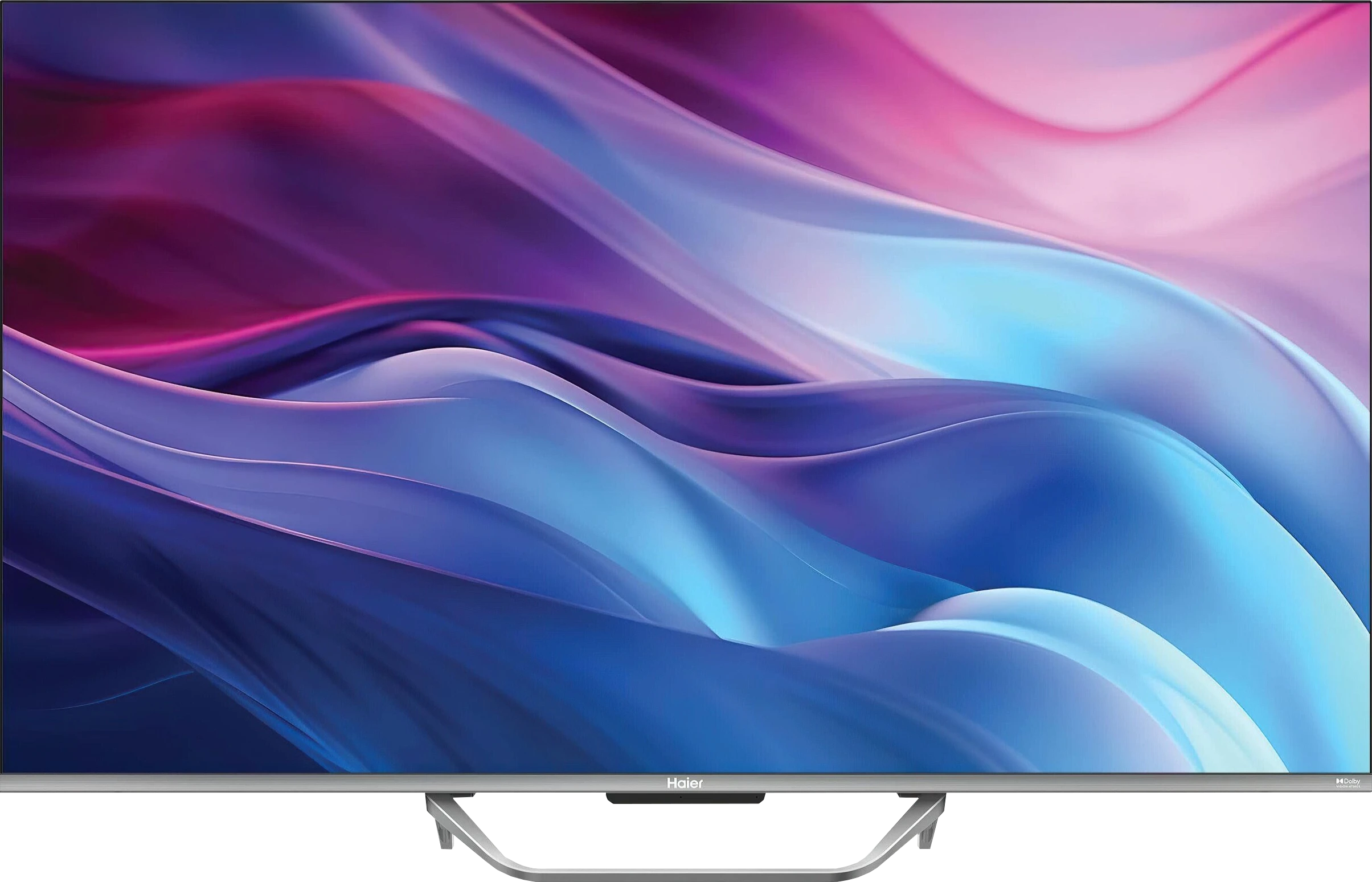
Panel type: LCD VA
Resolution: 3840x2160
System: Google TV
Model year: 2024
Complete the survey to find out the result

Panel type: LCD VA
Resolution: 3840x2160
System: Google TV
Model year: 2025
Complete the survey to find out the result

Overall rating
6.4
5.8
Movies and series in UHD quality
6.2
5.9
Classic TV, YouTube
6.1
5.6
Sports broadcasts (TV and apps)
6.4
4.7
Gaming on console
7.8
6.7
TV as a computer monitor
4.0
6.0
Watching in bright light
4.5
4.8
Utility functions
6.0
5.6
Apps
9.6
9.6
Sound quality
7.0
5.5
Complete the survey to find out what fits your preferences
Advantages
VA matrix with decent contrast
144 Hz refresh rate and two HDMI 2.1 ports – a great option for gamers
Support for VRR and ALLM, low input lag
Dolby Vision support
Google TV with a rich selection of apps, voice search in Polish, and an intuitive interface
Decent sound
Very good native contrast and decent black (thanks to the VA panel)
PFS / QLED Filter - Wide colour gamut (about 95% DCI-P3)
Remarkably low input lag (below 10 ms at 120Hz and about 12 ms at 60Hz), making it a great choice for fast-paced games.
Support for 120Hz at lower resolution (Full HD) and the presence of VRR and ALLM
Support for Dolby Vision
Well-functioning file player via USB
Presence of analogue headphone output (jack)
Disadvantages
HDR brightness is lower than claimed by the manufacturer (around 360 nits instead of 500)
In PC mode, it does not support 4:4:4 chroma – text and fonts are therefore less readable
No USB recording and PiP function
No support for AirPlay – Apple device owners may feel disappointed
The image is quite "blown out" in HDR
Google TV software is full of bugs, poor translations, and issues
Lacks any image enhancement features (noise reduction, gradient smoothing)
Average brightness
Flat, bass-less sound
High input lag in Dolby Vision mode for gaming
Weird and not very ergonomic remote
Our verdict
The Haier Q80FUX television is one of the most schizophrenic propositions we have had in our editorial office for a long time. On one hand, we have a solid piece of equipment: a VA panel guaranteeing deep blacks, as expected for this segment, and a QLED quantum filter that can indeed generate juicy, eye-catching colours. This is the foundation on which a truly competitive mid-range receiver could have been built. Unfortunately, all this potential of the matrix is systematically undermined by the software, which is a real anchor for this model. The biggest Achilles' heel of the Q80FUX is its total capitulation in dealing with HDR10 materials. The electronics seem to completely misunderstand how to interpret the signal, resulting in it consistently blowing out the brightest parts of the image, turning them into a flat, milky spot. Adding to this is the Google TV system, which – while functional – is unstable, full of bugs and annoying oversights, giving us an image of a raw product that clearly reveals the producer's lack of experience. Just when we were about to write this model off, we discovered its surprising niche. After connecting a console, the Q80FUX undergoes a transformation. It turns out that this television offers remarkably low input lag, fully supports VRR, and can handle a 120Hz signal in Full HD resolution. In the gaming world, where responsiveness is everything, these parameters put it in a very good light. So we are dealing with a device of very narrow specialization. It is not a universal living room television – it lacks stability and, above all, any correctness in handling films. It is rather a budget, large-format monitor for gamers, who can consciously forgive it all the software flaws in exchange for those few key attributes for console/PC at a relatively affordable price.
TV appearance




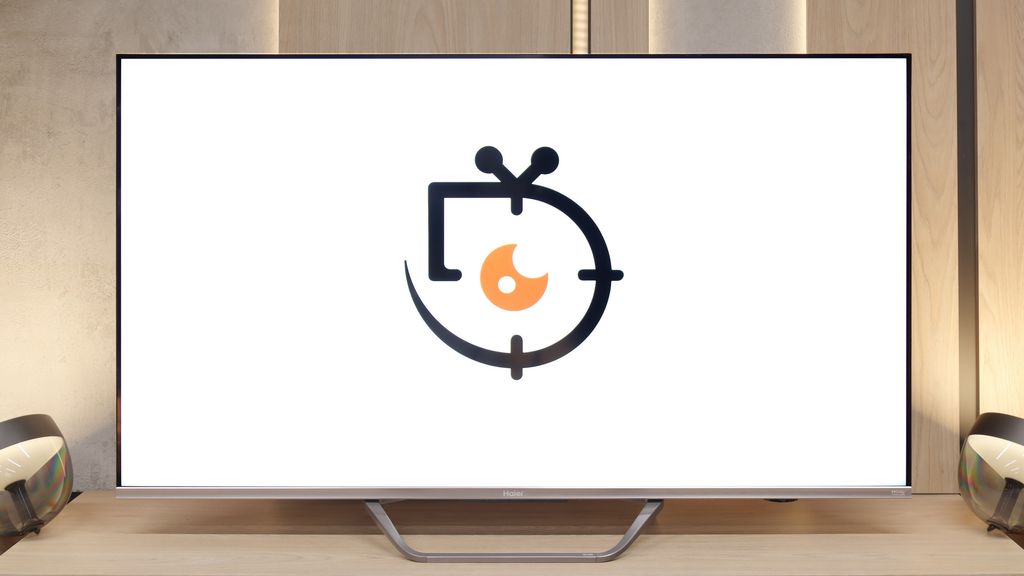

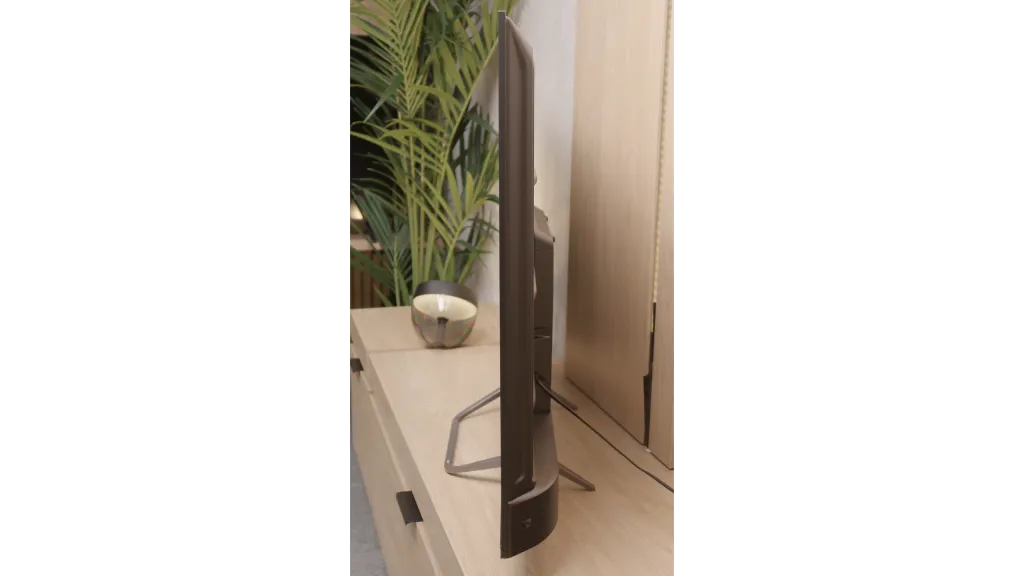
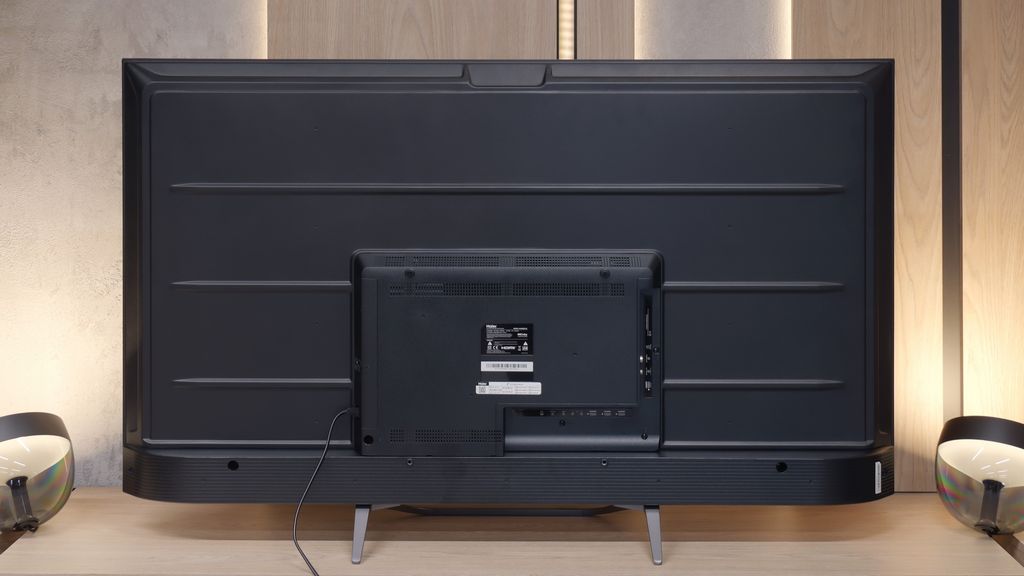
Contrast and black detail
5.9/10
6.3/10
Local dimming function: No
Local dimming function: No
Contrast:

Result
5,300:1

Result
5,800:1

Result
6,600:1

Result
5,650:1

Result
4,700:1

Result
5,200:1

Result
7,400:1

Result
7,550:1

Result
7,300:1

Result
6,450:1
Halo effect and black detail visibility:

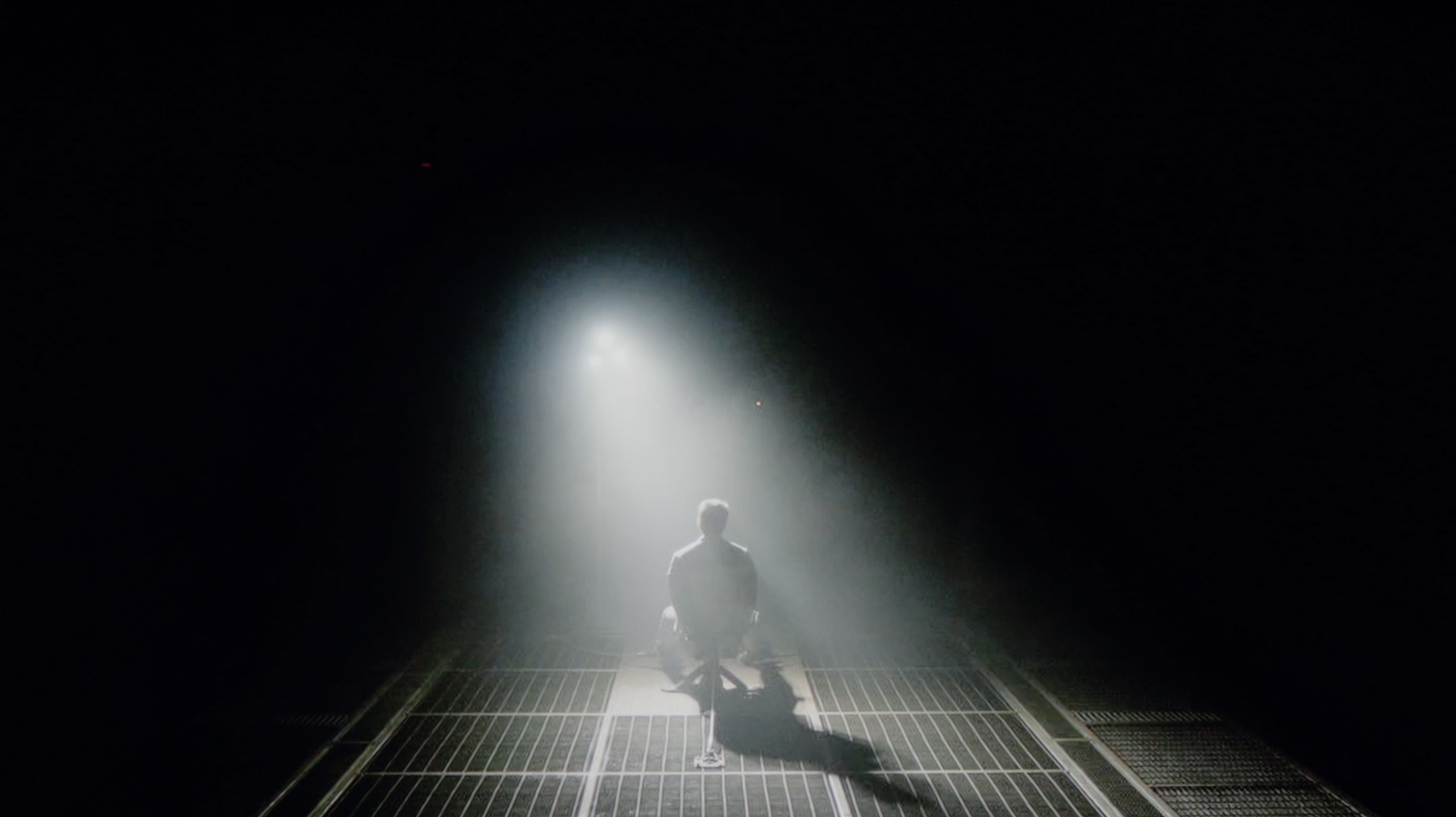
Sharp GR8 uses a VA panel, which can provide quite decent contrast. In tested movie scenes, for example in “Arrival,” the television showed that it can achieve really good results. A contrast ratio of 6600:1 is a figure that can be considered solid in this price segment. However, it should be noted that the television is not equipped with local dimming technology. This is quite obvious, considering the class of the equipment. Despite this, Sharp GR8 performs well with the separation of bright and dark elements, which definitely deserves recognition. However, it's important to remember that televisions without local dimming have their limitations. In very dark conditions, such as during a viewing in a completely dark room, black may take on shades of navy instead of appearing deep and pitch black. Overall, Sharp GR8 offers quite solid contrast that should satisfy most users.
I must admit that approaching a TV in this price range, one instinctively crosses their fingers, hoping that at least the black won't be a grey blotch. Meanwhile, the Haier Q80FUX, specifically the 55-inch unit we have in our office, can pleasantly surprise in this regard. Its secret lies in the use of a VA panel, which tends to generate high contrast by nature. And these are not empty promises. During screenings, in the majority of film scenes, the contrast reported itself at levels ranging from 5000:1 with commendable regularity, often reaching as high as 8000:1. These are really strong results, considering the fact that this TV has no, not even minimal, form of local dimming. Translating this into couch-side experiences: for its price point, the Q80FUX offers solid black levels. Of course, it isn’t that perfectly velvety depth that makes the screen disappear into darkness. When we conduct a viewing in total light isolation, we can see that in the darkest parts of the image, the black betrays its budget origins, subtly shifting towards a bluish glow. However, this is a defect that is easy to mask – just a bit of light from a lamp in the corner of the room is enough for this nuance to become invisible, and the image regains a satisfying depth.
HDR effect quality
4.8/10
4.9/10
Luminance measurements in HDR:

Result
305 nit

Result
332 nit

Result
369 nit

Result
365 nit

Result
367 nit

Result
308 nit

Result
327 nit

Result
352 nit

Result
330 nit

Result
344 nit
Scene from the movie “Pan” (about 2800 nits)


Scene from the movie “Billy Lynn” (about 1100 nits)


Static HDR10


Dynamic: Dolby Vision
Dynamic: Dolby Vision


HDR luminance chart:
Haier Q80FUX
HDR luminance
Sharp GR8
HDR luminance
Sharp GR8 in its promotional materials boasts of "very high brightness" at a level of 500 nits. Unfortunately, our tests showed that reality is somewhat different – the average luminance we were able to achieve was around 360 nits. This is rather an average result, especially in the context of the manufacturer's claims. Such brightness does not allow for a full enjoyment of HDR effects. The image is a bit sharper than in standard SDR, but it's hard to talk about true vibrancy and depth of bright elements here. However, the coverage of the DCI-P3 colour palette at 95% deserves praise. This is the result of applying an additional PFS coating, known from QLED technology. As a result, colours are vibrant and have a pleasant, natural tone, which partially compensates for the shortcomings in brightness.
Alright, let's move on to the topic that really sparks discussions, which is the capabilities of the TV in HDR mode. Let's be clear from the start: the Haier Q80FUX is certainly not a brightness demon. The panel of this set can generate about 350 nits at peak, which in today's reality is an absolute minimum to even talk about the presence of HDR expanded dynamic range. On the plus side, this brightness is at least stable – regardless of the test pattern or film scene we used, measurements consistently hovered around 300-350 nits. These are at best adequate results, definitely far from the dazzling display of capabilities that we know from more expensive models. Fortunately, there is one aspect where the Q80FUX makes up for these shortcomings and does so considerably. We are talking about a QLED TV (or more precisely PFS LED), which means that thanks to the quantum dot filter used on the panel, it can generate truly juicy, vibrant colours. These are not empty promises – covering nearly 95% of the DCI-P3 colour gamut is an impressive result and directly translates into very pleasant, saturated colours for the eye.
Factory color reproduction
5.4/10
4/10


Factory Mode
After calibration
At the beginning, it's worth noting that colour reproduction tests are always conducted in the best factory picture mode. In the case of Sharp GR8, this is the “Film” mode. When it comes to white balance, which affects how we perceive colours on the screen, in SDR mode the strong dominance of blue immediately stands out. This results in an unnatural cooling of the image – blue elements take on a purple hue, and skin tones appear to have a pink tint, which we can see in the comparative photo from the film STAR WARS. During the Color Checker test, it was clearly visible how the colour samples deviated from the standard values, confirming significant errors in colour reproduction. The gamma was also not ideal – it caused excessive brightening of the entire image, causing the scene to lose depth and proper tonal transitions.
In the 4K HDR mode, the situation looks much better. The dominance of blue is much less noticeable, although there are minor issues with the blending of red and blue. This makes some shades look slightly unnatural. The EOTF curve, which is responsible for image brightness in 4K HDR content, showed another problem – the TV tends to excessively darken the image across the entire surface of the screen.
To summarise, the “Film” mode in Sharp GR8 would require some adjustments in order to fully utilise the potential of this television. Fortunately, we took care of this and proceeded with calibration.
Factory settings for movie mode are seldom perfect, but in the case of the Q80FUX, we encountered a noticeable imbalance. In SDR content, the image was definitely too warm, due to an excessive amount of red in the white balance, giving the overall picture a slight sepia tone. Conversely, in HDR materials, the television fell into the other extreme – an excess of blue caused an unnatural, cool effect in perception. However, it wasn't the fickle white balance that was the biggest issue with this TV. The real culprit, responsible for the previously described problems, was hiding deeper. It turned out that the Q80FUX has completely miscalibrated gamma values and, crucial for HDR, a poorly executed EOTF curve. It was these erroneous factory settings that caused the notorious clipping of the brightest parts of the image, imposing that characteristic milky filter over them. Thus, we found the source of the problem. This situation led to general, significant colour inaccuracies that were easy to catch even for an untrained eye. Like every television we tested, we decided to calibrate this model as well, and you can find the results of these adjustments in the next paragraph.
Color reproduction after calibration
8/10
6.1/10




Sharp GR8 is one of those televisions that really gains a second life after proper calibration. Both in HD and 4K content, the white balance performs very well, especially considering this model's price segment. The picture becomes significantly closer to what the director intended to show – colours appear natural, and skin tones gain the right depth and warmth. The brightness characteristics also leave a very positive impression. Both the gamma and the EOTF curve demonstrate really solid values. While slight imperfections can be noticed, they are subtle enough that it's difficult to see them during everyday viewing. In summary, calibration allows Sharp GR8 to show its best face, offering a picture that is not only pleasant to the eye but also faithfully conveys the creators' intentions.
The results of our calibration procedures must, unfortunately, be regarded as twofold. Generally speaking, the picture is undeniably better than before the adjustments; however, the biggest winner of this process has been SDR content. It is precisely here, after correcting the gamma curves and white balance, that we achieved results that can safely be called very good. Once set up, the Q80FUX truly shines in standard dynamic range, displaying only slight errors in the most challenging skin tones. Unfortunately, the weakest link remains HDR content. And here's the paradox: even though we managed to calibrate the white balance to near perfection, the overall colour errors still remain at quite a high level. The reason is that the television still interprets the static HDR10 metadata "in its own way," stubbornly enforcing that unfortunate image clipping effect, which inevitably leads to significant distortions. Although we successfully eliminated the factory excess of blue, due to this electronic interference, the screen can still veer into somewhat too cool tones. That’s just how this television is.
Smoothness of tonal transitions
8/10
7.5/10












When it comes to the fluidity of tonal transitions in high-quality materials such as 4K, Sharp GR8 performs really well. Colour gradients are smooth, and transitions between shades are natural and free from visible artifacts. The television has no issues reproducing subtle differences in colours, even in demanding scenes. Only the most discerning users, who closely examine the image, may notice slight imperfections in the darkest shades. For most viewers, the quality of tonal transitions in the Sharp GR8 will be more than satisfactory and will not negatively affect the perception of the image.
Analysing the ability of the television to handle subtle tonal transitions, or "banding", leads us to some interesting conclusions. The Haier Q80FUX seamlessly blends adjacent colours in most scenes, creating a smooth, cohesive image. However, this process is not without its flaws. During our tests, we noticed minor issues and imperfections in each of the test scenes we used. These may not be errors that aggressively jump out and ruin the viewing experience, yet their presence is worth noting. Interestingly, this receiver does not exhibit any particular weaknesses or strengths in this regard – it handles this challenge in exactly the same way, regardless of whether it is displaying delicate gradients of a bright sky or dark transitions in shadows.
Image scaling and smoothness of tonal transitions
5.5/10
4/10
Smooth transition function

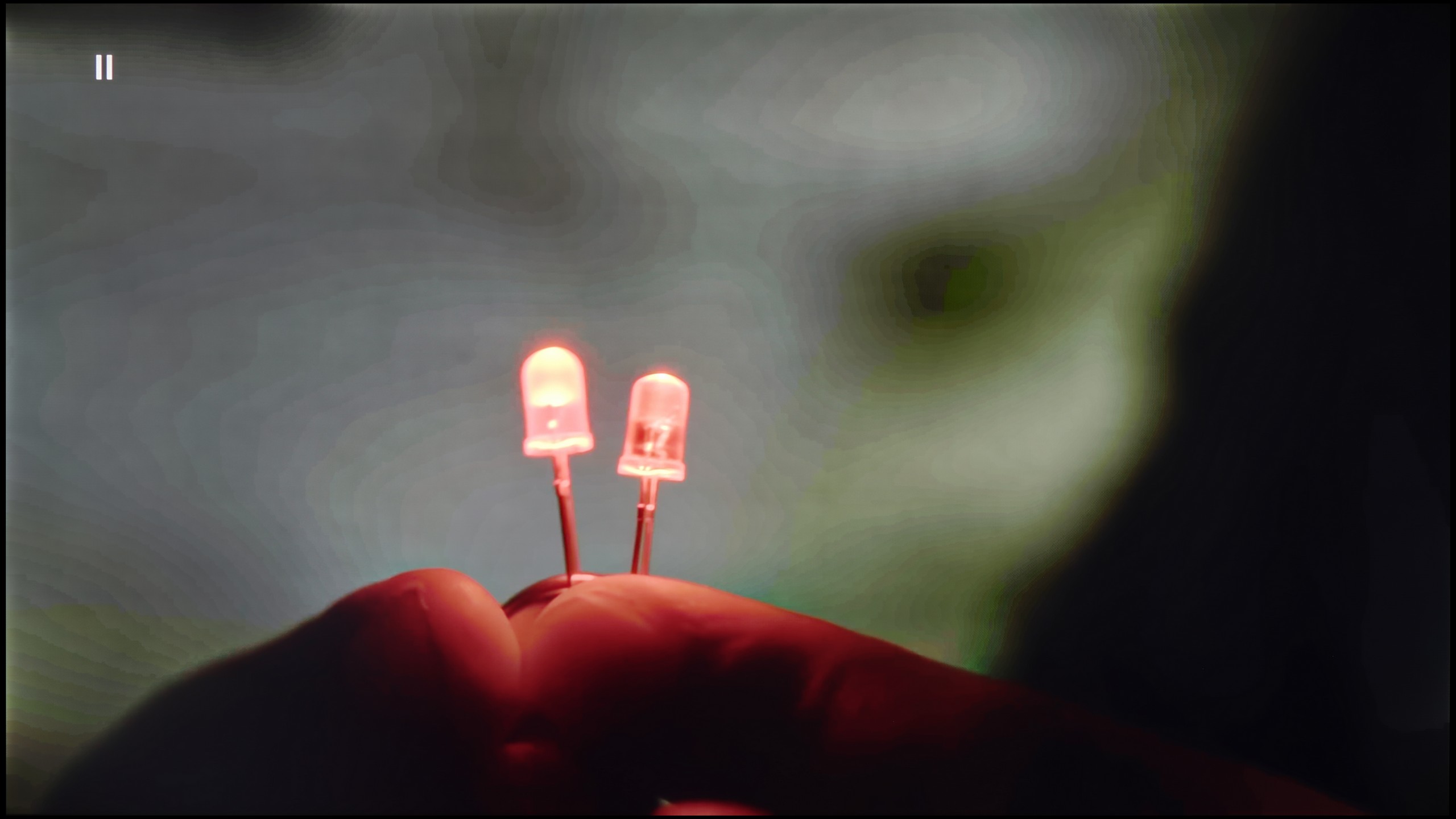
Image without overscan on the SD signal


Sharp GR8 is equipped with a feature called "10-bit colour reproduction," which theoretically should improve the smoothness of tonal transitions. In practice… well, the effect is surprising, but not in a very positive way. Even at the highest settings, it’s hard to notice any impact on the actual tonal transitions. Instead, the feature surprisingly smooths out things it shouldn’t - walls, shirts, or other flat surfaces look almost as if they have been ironed. In the test, we had to note that there is simply no actual impact on tonal transitions.
When it comes to image scaling, Sharp GR8 performs significantly better. The television can give the image a plastic, smooth characteristic, making even lower resolution content look quite good. Of course, with more demanding details, such as thin branches of trees in the background, you can see slight jaggedness, but it’s not something that would significantly affect the viewing comfort.
If there's one area where Haier clearly shows it still has a lot to catch up on compared to the market leaders, it's digital image processing. The upscaling, well... it's just okay. And that's really all that can be said about it. It does what it's supposed to do: ensures that lower resolution signals don't scare you with harsh pixelation on the screen and don't look like a forcibly enlarged postage stamp. However, it's far from the finesse and "intelligent" sharpening that more experienced players in this market have developed over the years. The biggest issue with the Q80FUX software is the almost complete lack of additional "cleaning" and smoothing features for the image. The receiver offers no noise reduction mechanisms or gradient enhancement. This means that with older or highly compressed materials, we simply have to accept that all the imperfections in tonal transitions or colour blending, which we mentioned earlier, will constantly accompany us during viewing.
Blur and motion smoothness
7.4/10
4.5/10

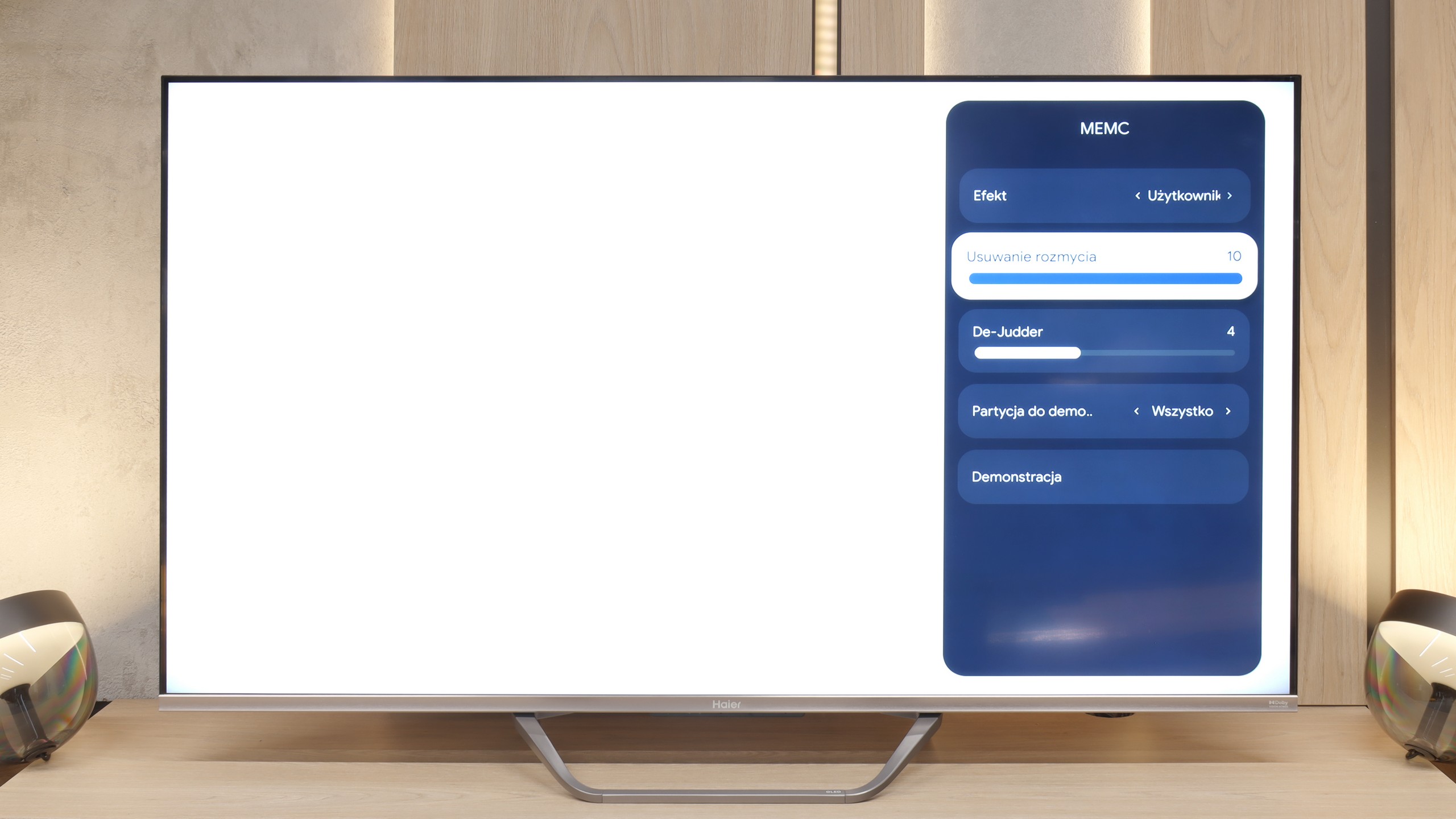
Blur (native resolution, maximum refresh rate):




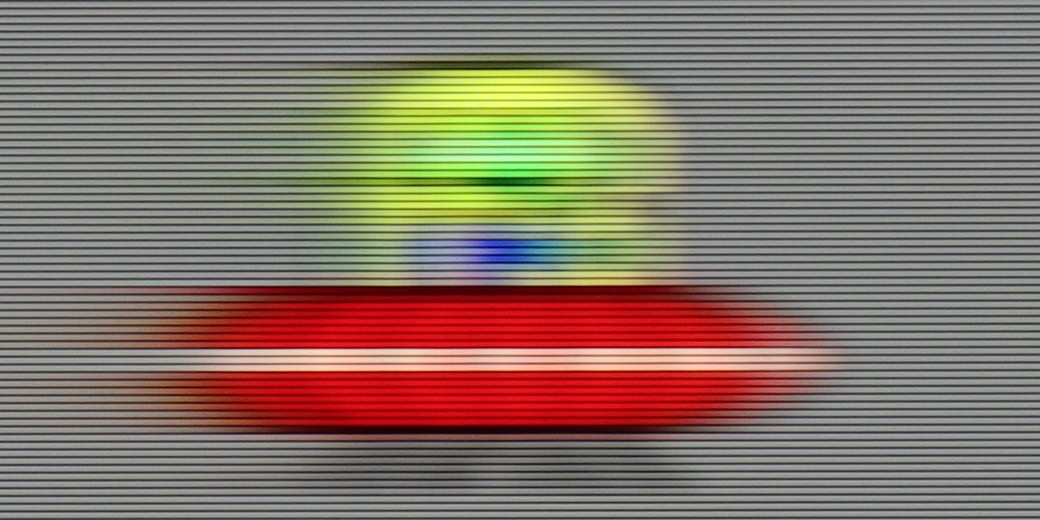

This is where Sharp GR8 has the opportunity to stand out against the competition in its price segment. The television is equipped with a 144 Hz refresh rate panel, which is an impressive result, especially if we plan to use it for dynamic content such as action films, sports broadcasts, or video games. Additionally, the manufacturer has included a motion smoothing feature, commonly known as a 'smoother'. The user has three levels of adjustment available, allowing them to tailor the effect to their personal preferences – from subtle smoothing to a more aggressive intervention in the fluidity of the image. It's a nice addition, particularly for those who mainly watch films and care about smooth, cinematic sequences without annoying judders or stuttering.
The issue of motion fluidity and blurring is largely predetermined by the use of a 60Hz panel, which naturally makes it difficult to recommend this receiver to enthusiasts of very dynamic content. Fortunately, in the Q80FUX, we find a few options (although, as will soon become clear, really just one) intended to enhance the experience with older film productions. There is a "De-Judder" slider available, which indeed affects motion fluidity and allows us to adjust it to our preferences: from raw, cinematic frame rates to a more theatrical, smoothed presentation. However, a true surprise awaits us right next to it in the menu. There is also a second slider, supposedly dedicated to removing blur – this is a feature we typically encounter in 120Hz panels, aimed at combating blurring in sports. As we expected, recalling memories from testing the K85F model, here too this slider is merely a façade. Its adjustment contributes absolutely nothing to the picture and simply seems to be an oversight by the product engineers who left a non-functional option in the software for this type of panel.
Console compatibility and gaming features
7.8/10
5.6/10
- ALLM
- VRR
- VRR range48 - 144Hz48 - 120Hz
- Dolby Vision Game Mode
Yes, high input lag
- Correct implementation of HGIG
- 1080p@120Hz
- 1440p@120Hz
- 4K@120Hz
- Game bar

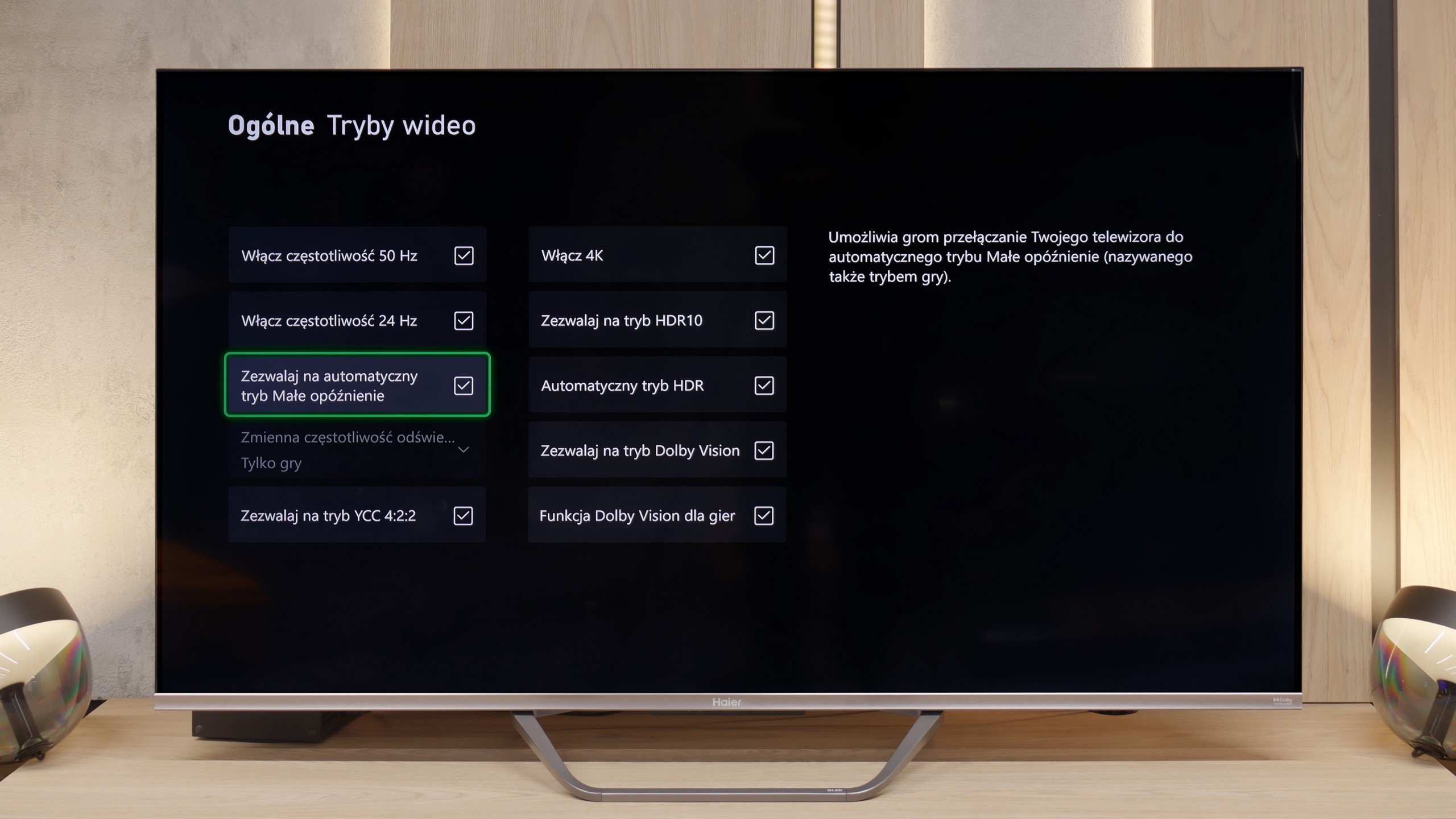

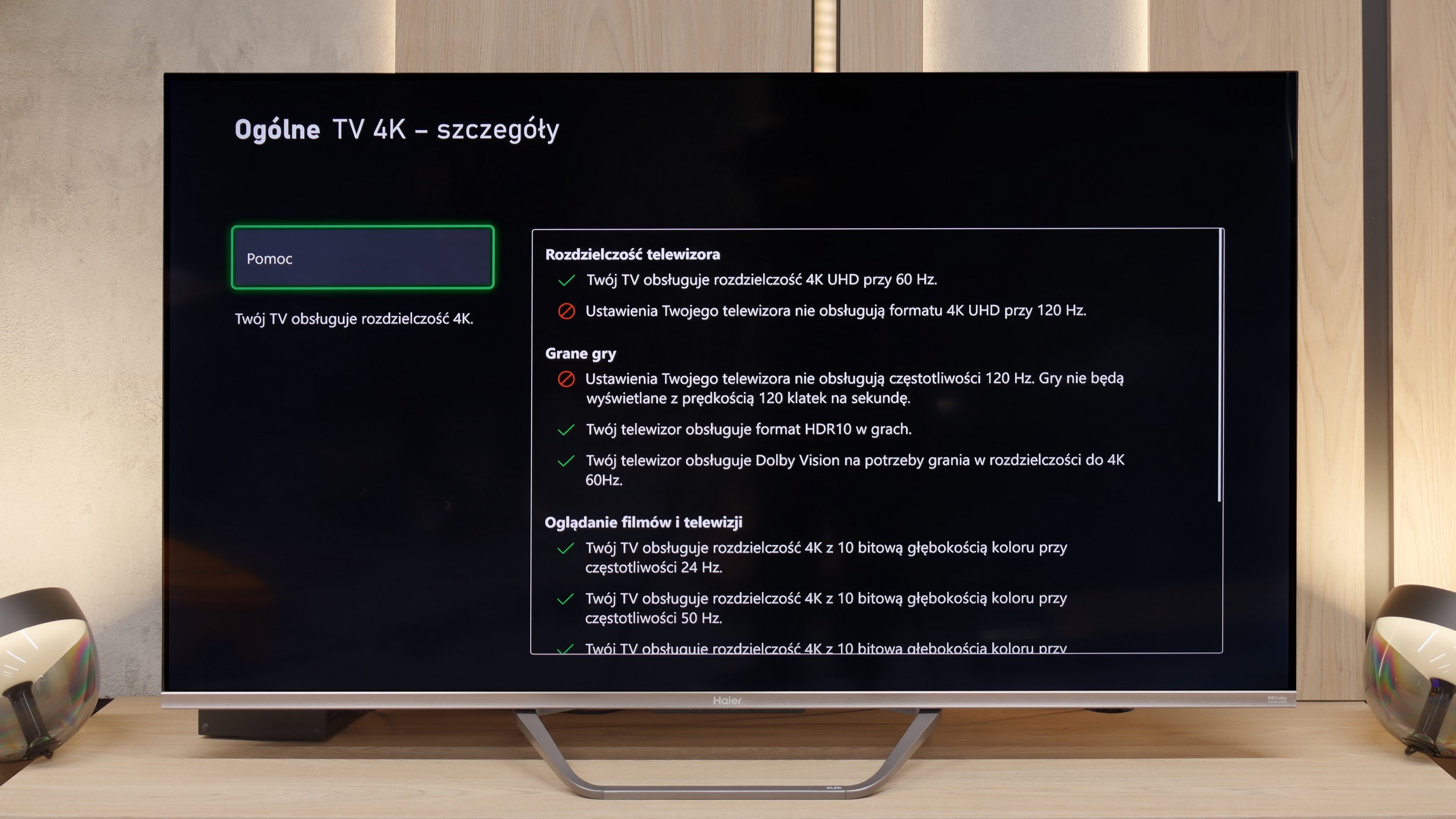

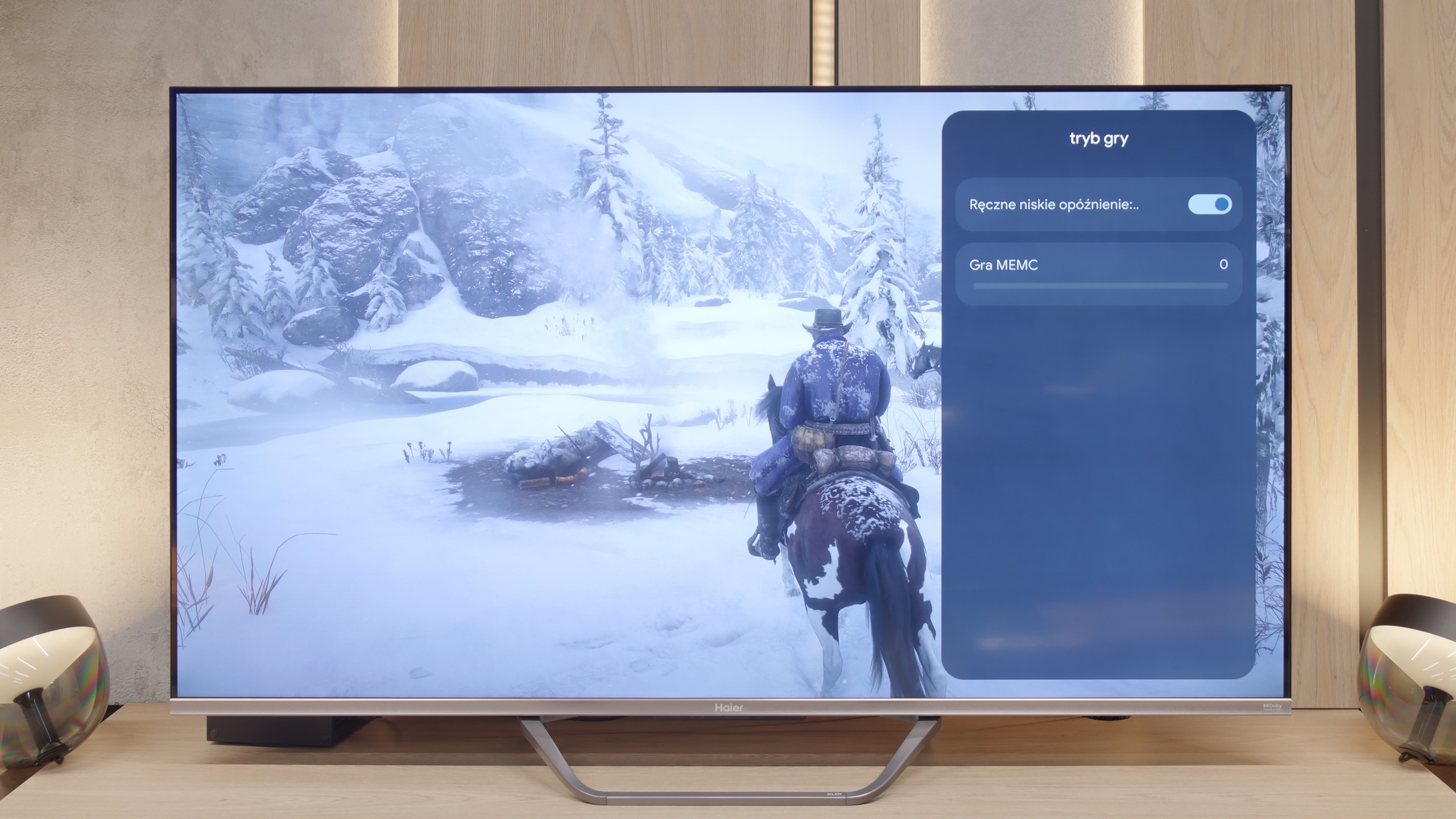

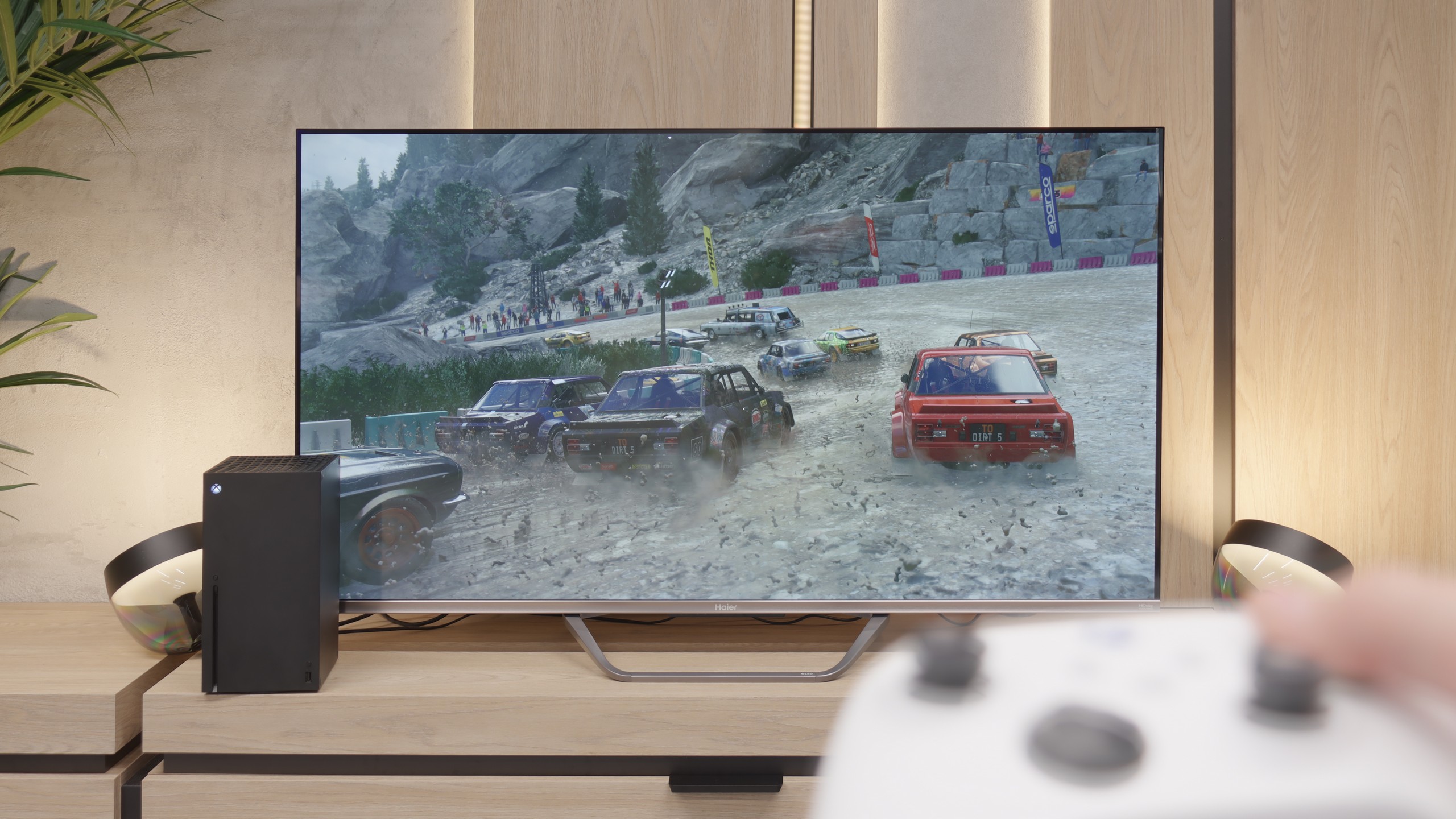
If the television has a 144 Hz panel and two full HDMI 2.1 ports, it’s clear it was designed with gamers in mind. The Sharp GR8 offers exactly that – high refresh rates and the right connections to get the most out of modern consoles and PCs. It also features ALLM, which automatically switches the TV to low latency mode, and VRR, ensuring the picture doesn’t stutter even in more demanding moments. In practice, everything works as it should, and it's difficult to find fault. However, it’s not without its shortcomings. There’s a lack of support for HGiG, which better adjusts HDR for games, as well as Game Bar, which makes it easier to quickly adjust settings without leaving the game. Despite these drawbacks, the Sharp GR8 is a really solid option for gamers.
Entering the realm of gaming, the Haier Q80FUX proves to be quite a good companion for the "casual gamer." It is equipped with some highly sought-after features today such as VRR (variable refresh rate) and ALLM (automatic low latency mode). However, the biggest surprise is something else. Even though we don't have a 4K@120Hz panel here, the television can accept and display a 120Hz signal at a lower resolution (Full HD). This is a very useful feature, allowing you to consciously switch the console to a lower resolution mode in exchange for significantly higher fluidity, which is a perfectly acceptable compromise in the gaming world.
We won't particularly complain about the lack of additions like the "Game Bar," as it's just a nice extra. However, the most concerning issues arise when we enter the world of HDR in gaming. Due to the fact that the television continuously adapts the signal "in its own way," setting the brightness on the console according to the HGIG standard is almost impossible to accomplish according to the instructions. Worse still, in Dolby Vision mode for gaming, the input lag increases to around 50 ms, which is a high enough value that essentially makes this mode unusable. Generally speaking, we still wouldn't recommend gaming on this television in HDR mode, so these aren't that serious shortcomings. What’s most pleasing is the presence of 120Hz in Full HD, making the Q80FUX quite a cool television for the occasional gamer.
Input lag
9.7/10
9.4/10
SDR
HDR
Dolby Vision
Sharp GR8 performs really well in terms of delays. With a refresh rate of 120 Hz, the input lag is only 9 ms, and at 60 Hz – about 18 ms. These values are practically imperceptible even for the most demanding gamers, where every millisecond counts. Importantly, the Dolby Vision mode also works responsively, which is not a standard in TVs within this price range. This is definitely a big plus for those who want to enjoy not only smoothness but also better HDR effects while gaming.
If there is one category in which the Haier Q80FUX absolutely shines and shows its claws, it is input lag. In this respect, the TV presents downright outstanding results. In 120Hz mode (achieved, let's remember, at a lower resolution), input lag drops below 10 ms, which is an excellent value, worthy of top gaming monitors. Only slightly worse, but still at a very good level, is the classic 60Hz mode – here, measurements consistently indicated around 12-14 ms. These are results that much more expensive, dedicated gaming constructions would not be ashamed of. The only, but significant, stumbling block is the Dolby Vision mode. As we established earlier, its activation raises input lag to an unacceptable level, so we definitely advise against using it during any interactive gameplay.
Compatibility with PC
4/10
6/10

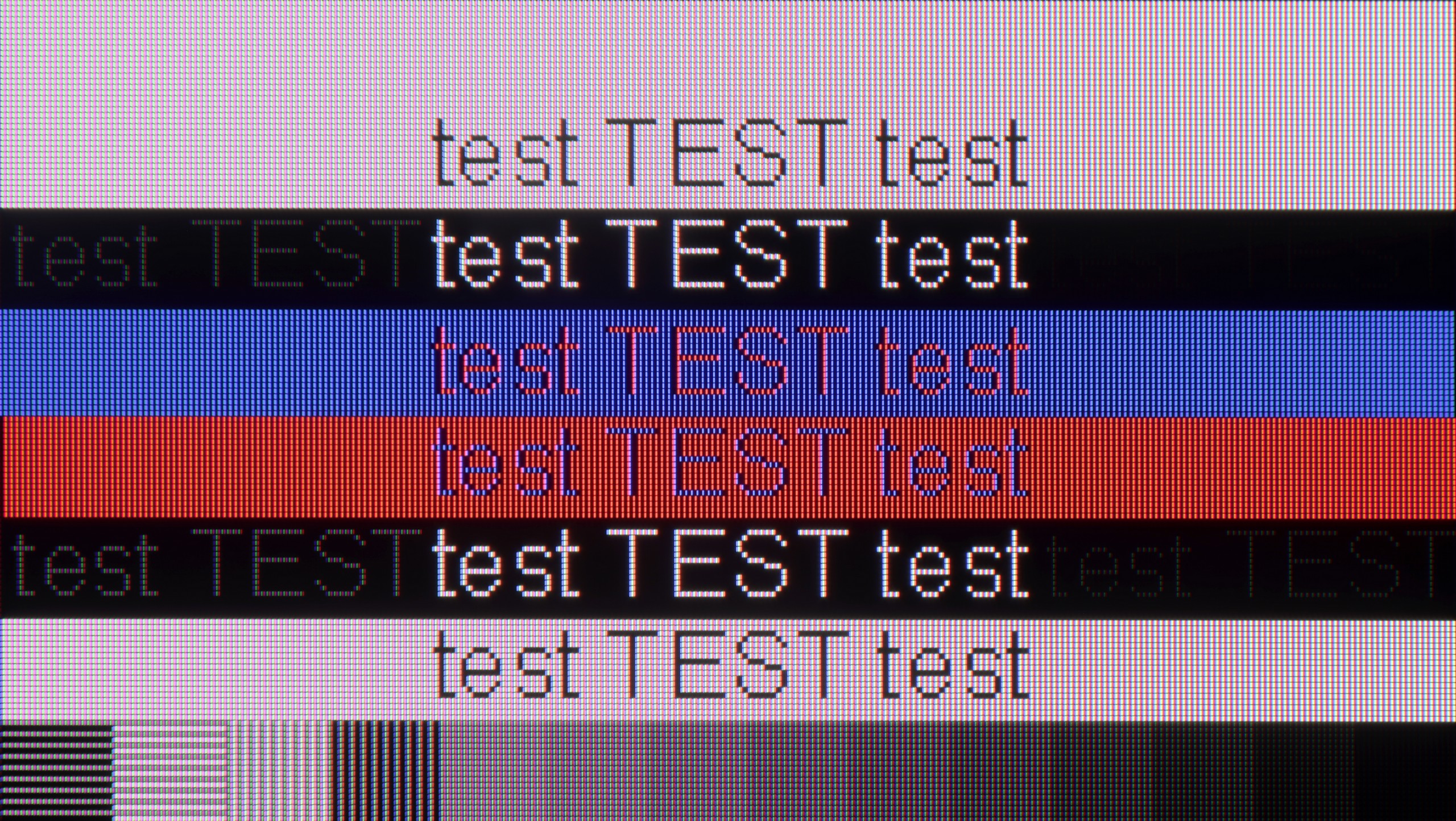
Sharp GR8 performs quite well as a screen for PC gaming. With a refresh rate of 144 Hz, low input lag, and support for G-Sync and FreeSync technologies, it's a set that guarantees smooth and responsive gameplay. Games look dynamic, and the image remains stable even in the most demanding moments. However, a problem arises when it's time to work with text. The television does not support chroma 4:4:4, which means fonts are blurred and difficult to read. Longer work with documents or browsing websites can become simply tiring on the eyes.
Sharp GR8 is a great choice for PC gamers, but rather poor for office work. If we plan to use this television mainly for gaming, we should be satisfied. However, if we think of it as a monitor for everyday work, it's better to look for another solution.
We also checked how the Q80FUX performs when connected to a computer. Here again, we were pleasantly surprised – it handles this really well. The most important thing is that the fonts are very readable, so nothing blurs and you can work normally on it. Additionally, just like with consoles: we can set a lower resolution here to achieve a high refresh rate of 120Hz in return. What’s crucial is that in this mode, G-Sync started correctly and functioned well. This just confirms that this television is truly a successful and efficient piece of gear for gaming, also on a PC.
Viewing angles
3.2/10
3.3/10
When it comes to viewing angles, Sharp GR8 doesn't surprise – and it's hard to blame it, considering the use of a VA panel. When watching from a more significant angle, the image loses quality, colours become washed out, and contrast noticeably drops. Additional coatings that widen viewing angles could improve this aspect, but that's a solution we typically find in more expensive LCD TV models. If we plan to watch television mainly straight on, there won't be much of a problem. However, in the case of a larger number of viewers sitting at different angles, it's worth being aware of this limitation.
Anyone planning screenings with a wide family group must be aware of the fundamental compromise that Haier has decided upon by implementing a VA panel in this model. This technology has indeed provided us with deep blacks and high contrast, but an inherent characteristic is also a noticeable narrowing of viewing angles. It’s enough to sit a bit further to the side of the couch to immediately notice how the colours start to lose saturation and the image fades. It’s simply a classic trade-off – we gain something (contrast) at the expense of something else (angles) – and the Q80FUX fits perfectly into this scheme.
TV efficiency during daytime
4.5/10
4.8/10

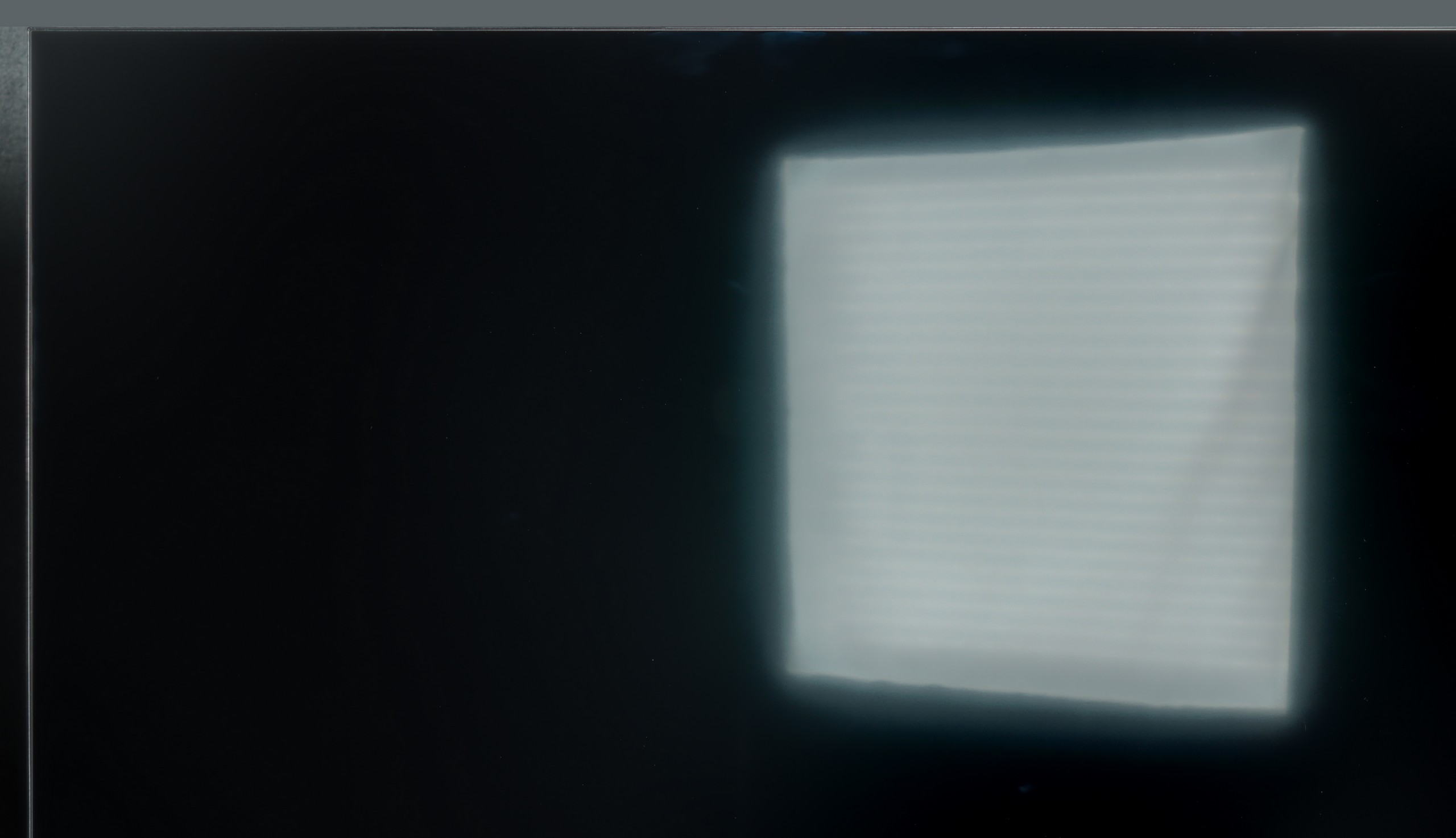


Matrix brightness
Average luminance SDR
Haier Q80FUX: 317 cd/m2
Sharp GR8: 329 cd/m2
Sharp GR8 has a satin finish display that performs average with reflections. Bright surrounding elements, such as windows or lamps, quite clearly reflect on the screen and can be distracting while viewing. The brightness level of 330 cd/m² in SDR content is also unimpressive. As a result, the television is best suited for rooms where not too much natural light comes in. So, it can be said that the GR8 holds up during the day, but it is certainly not equipment made for brightly lit living rooms. If we mainly watch in the evenings or in controlled lighting, it won’t be a major issue.
The receiver's clash with the daily challenges posed by a bright lounge is quite decent with the Q80FUX, although it's certainly hard to talk about perfection here. The panel itself is equipped with a coating that effectively manages to suppress most reflections and glare from the surroundings. Equally important, even in more challenging lighting conditions, the screen can maintain pleasantly saturated colours. However, the weakness of this construction is revealed when backlight brightness comes into play. The previously mentioned, rather moderate maximum brightness (around 350 nits) means that in confrontation with intense natural light coming through the window, the screen often struggles to "break through." On a sunny day, the image might simply lack the necessary expressive strength.
Details about the matrix
Subpixel Structure:

Panel uniformity and thermal imaging:


Sharp GR8
Haier Q80FUX
TV features
6/10
5.6/10
- HDMI inputs2 x HDMI 2.0, 2 x HDMI 2.1 48Gbps4 x HDMI 2.0, 0 x HDMI 2.1
- Other inputsRCA (Chinch)RCA (Chinch)
- OutputsToslink (Optical audio), eARC (HDMI), ARC (HDMI), Mini-Jack (Headphones)Toslink (Optical audio), eARC (HDMI), ARC (HDMI), Mini-Jack (Headphones)
- Network InterfacesWi-Fi 2.4GHz, Wi-Fi 5GHz, Ethernet (LAN) 100MbpsWi-Fi 2.4GHz, Wi-Fi 5GHz, Ethernet (LAN) 100Mbps
- TV receptionDVB-T, DVB-T2, DVB-S, DVB-S2, DVB-CDVB-T, DVB-T2, DVB-S, DVB-S2, DVB-C
Classic features:
- Recording to USB (terrestrial TV)
- Recording programming
- Picture in Picture (PiP)
- RF remote control (no need to aim at the screen)
- Backlit remote control
- Teletext
- Audio only mode
- Bluetooth headphones support
- Simultaneous Bluetooth headphones & TV audio
Smart features:
- AirPlay
- Screen mirroring (Windows Miracast)
- Voice search
- Voice search in native language
- Ability to connect a keyboard and mouse


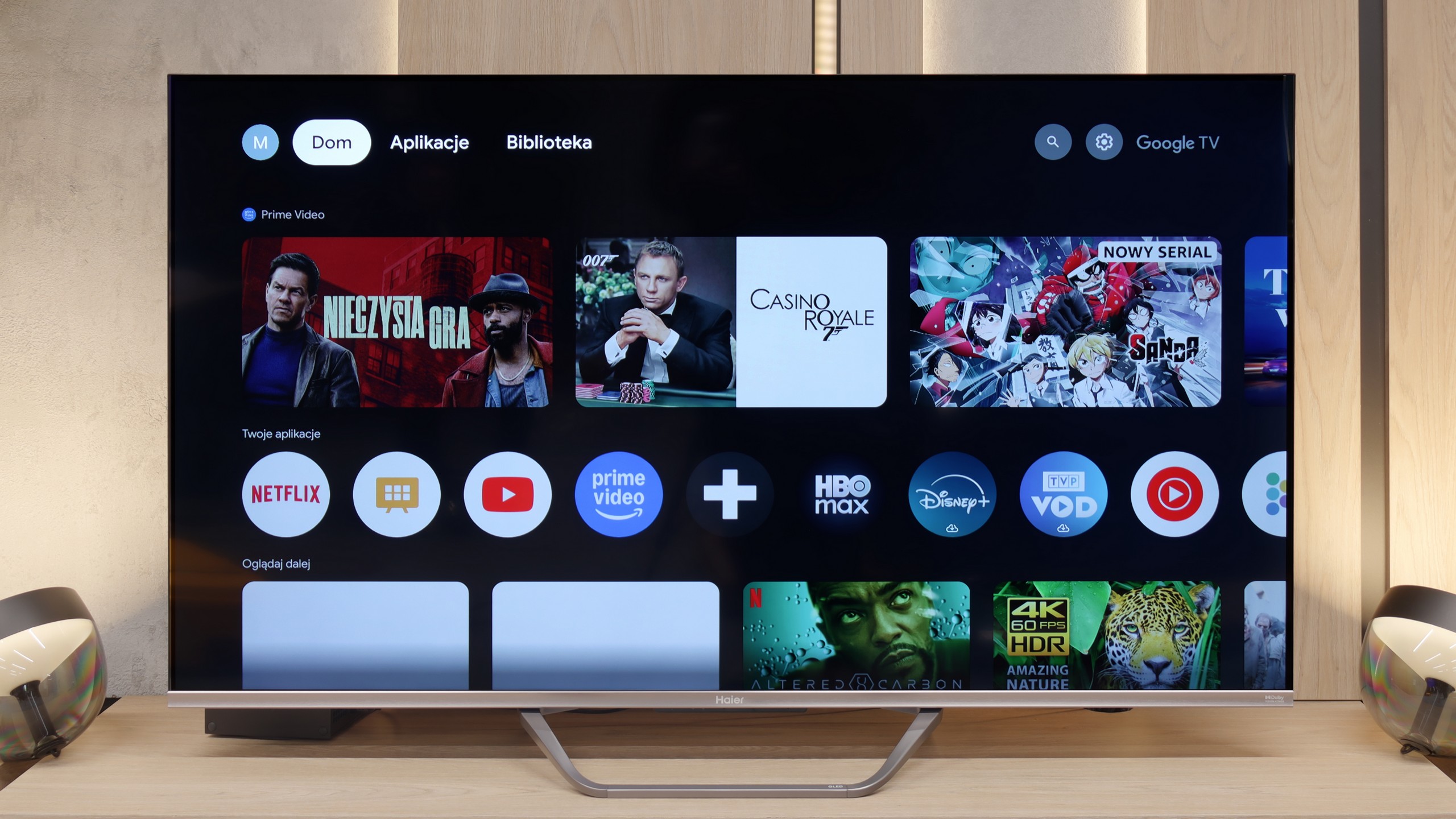
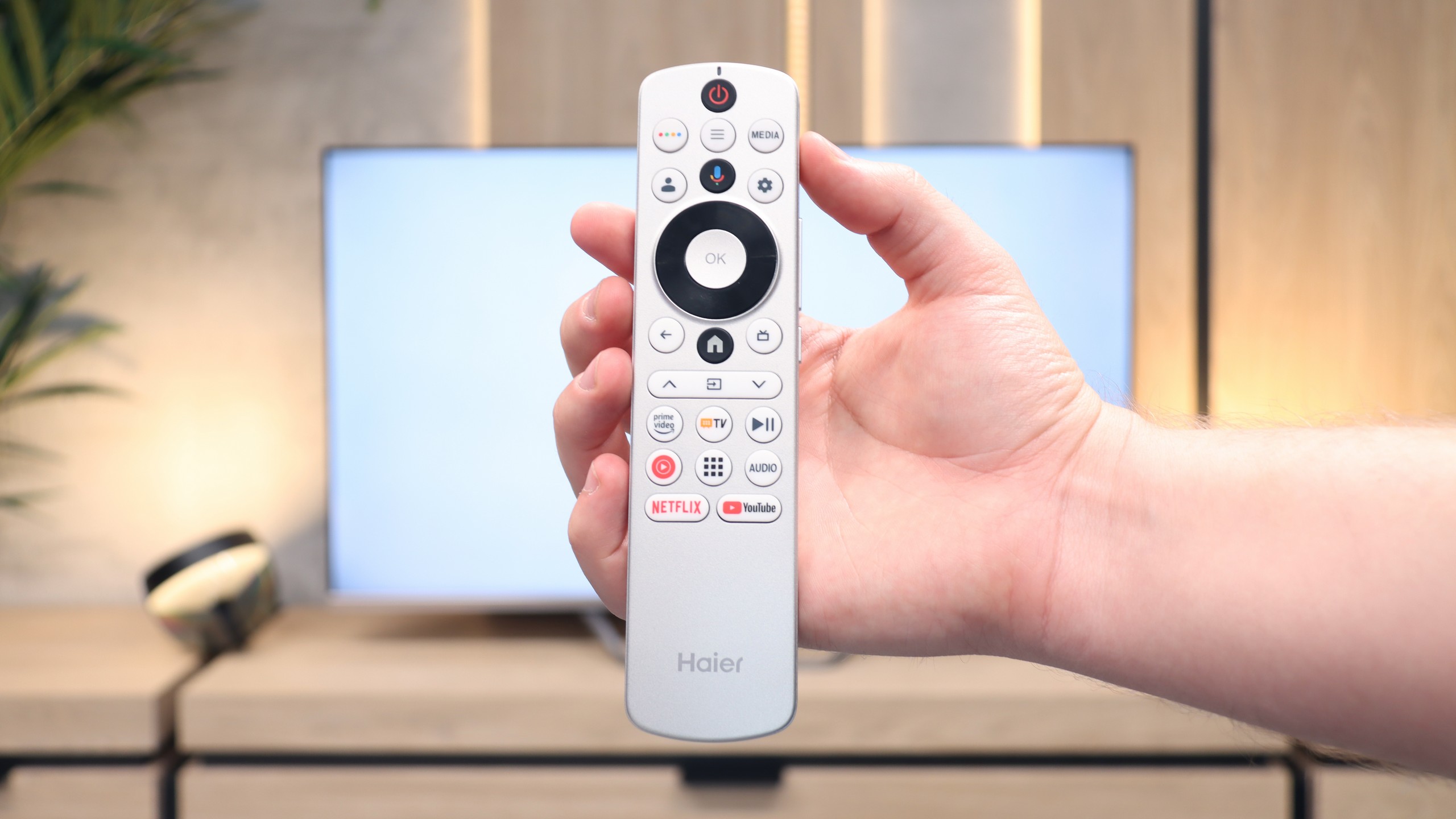
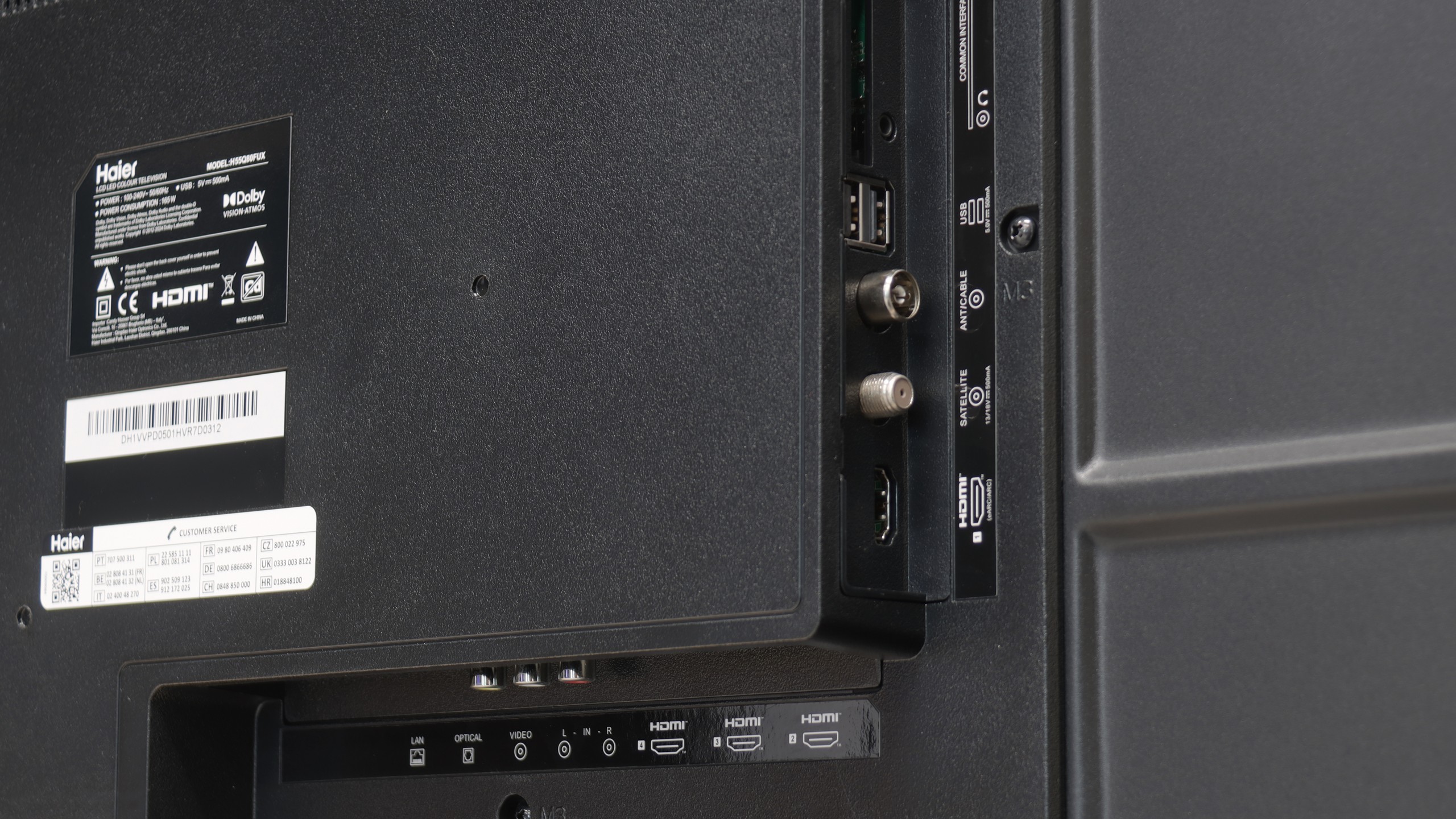
Google TV is definitely the biggest advantage of Sharpa GR8. This system is a true multimedia powerhouse – it includes practically all popular streaming apps, such as Netflix, HBO Max, and Disney+. Voice search works in Polish and, importantly, is really responsive. We can tell the TV what we want to watch, and it quickly finds the right content. Plus, the interface is clear and intuitive, so even people who aren't keen on technological innovations can manage without any problem. In short, Google TV gets the job done.
Unfortunately, when it comes to more classic functions, the GR8 is rather average. There are no options for USB recording or PiP (picture in picture) functionality. Moreover, although the TV supports Bluetooth connectivity, iPhone users may feel disappointed as there is no support for AirPlay.
The remote included is simple but well thought out. It has a solar panel on the front, allowing it to be charged by light, and the additional charging port means we don’t have to worry about changing batteries. Also, it’s a plus that the remote doesn’t require aiming at the screen – it works regardless of which way it’s pointed.
SmartTV on Haier Q80FUX: GoogleTV
First up, let's take a look at the smart layer, which in the Q80FUX is managed by the Google TV system. This is theoretically a huge advantage, providing access to an incredible library of apps, making it easy to cast from mobile devices, and offering convenient voice search. Unfortunately, like in other models from this brand that we've tested, the implementation of this platform leaves much to be desired. It’s not even about drastic freezes or delays in navigation, but rather a festival of minor bugs, shortcomings, and terrible translations in the menu. Because of this, it's hard to consider "Google TV" in Haier's version on par with what we know from Sony or TCL receivers, even though the same, proudly sounding name is on the box.
Classic Features
Moving on to the classic, functional features of the TV, the device's performance does not improve at all. The only thing worth praising is the presence of Bluetooth connectivity and an unusual but handy relic of the past in the form of an analogue headphone jack output. Apart from that, it's hard to find anything that would excite us. Due to the problematic software, the receiver (like its predecessors in our tests) was unable to find any terrestrial TV channels, even though other TVs connected to the same installation had no such issues. The remote control is also strange – its design may appeal to some, but due to the lack of a numeric keypad and the absurd placement of some buttons on the side edge, it definitely cannot be called senior-friendly.
Playing files from USB
9.1/10
9.6/10
Supported photo formats:
Maximum photo resolution:

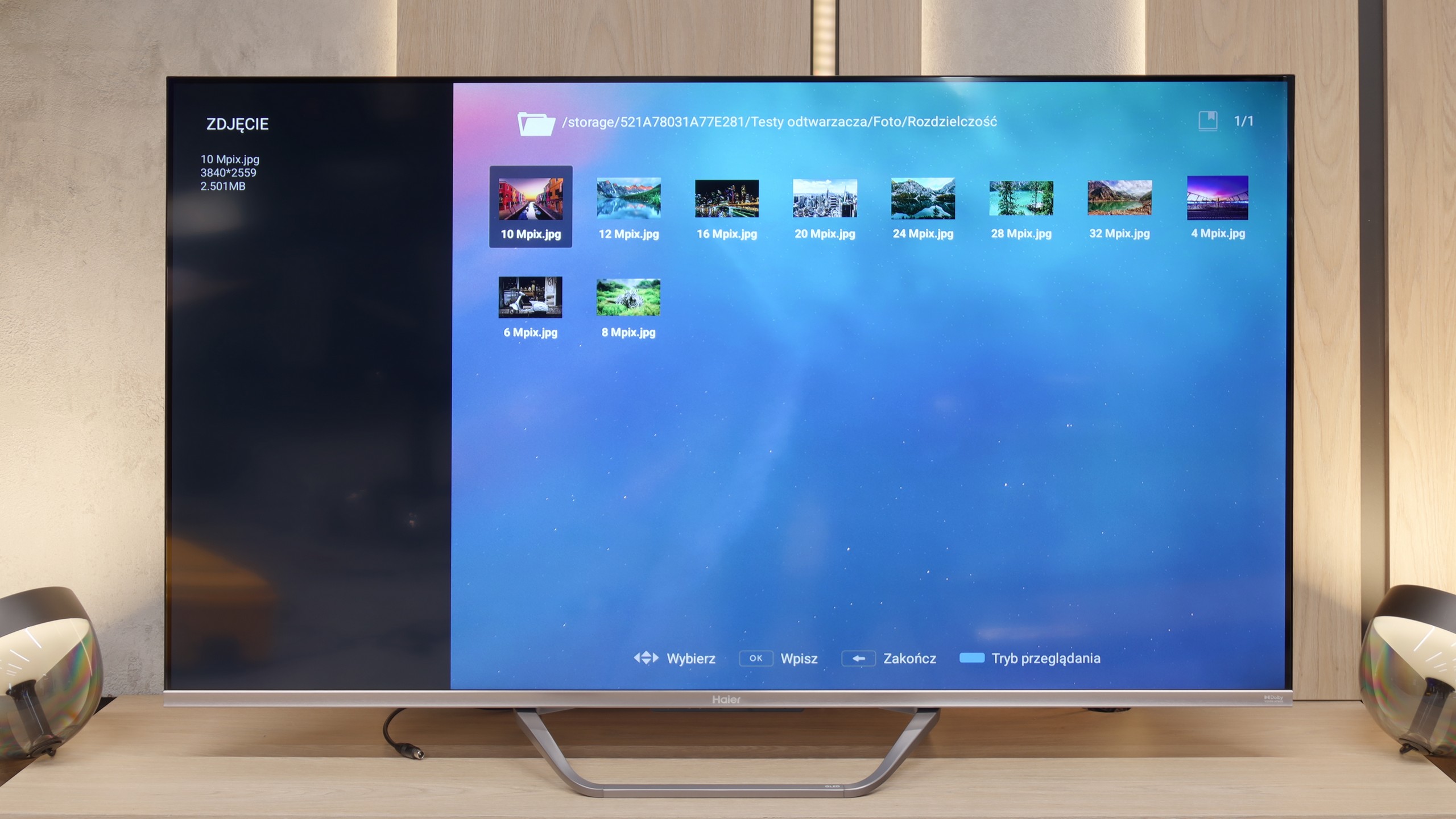
Sharp GR8 handles multimedia playback from USB really well. It supports practically all popular audio and video formats, so we don’t have to worry about any files not playing.
However, the built-in player has its limitations – for instance, we won’t find the option to change the font colour in subtitles here. Fortunately, the Google TV system allows us to bypass this issue. All you need to do is download an alternative media playback app from the Google Play Store that offers more advanced configuration options.
We must admit that after a series of setbacks we faced in assessing the overall implementation of the Google TV system, we approached the media player test with a fair bit of caution. Meanwhile, in this one specific aspect, the Q80FUX served us a real surprise. The built-in app for handling files from USB drives works simply brilliantly. This software component seems to be completely immune to the issues plaguing the rest of the system, opening practically all the most important and popular video file formats that we threw at it.
Apps
9.6/10
9.6/10














































Sound
7/10
5.5/10
- Maximum volume-84dB
- Dolby Digital Plus 7.1
- Dolby True HD 7.1
- Dolby Atmos in Dolby Digital Plus (JOC)
- Dolby Atmos in Dolby True HD
- DTS:X in DTS-HD MA
- DTS-HD Master Audio
Sharp GR8 pleasantly surprises with its sound quality. Although it comes with a standard set of speakers, you can hear the influence of collaboration with Harman/Kardon. The sound is clear, dialogue is well-highlighted, and the overall sound profile is pleasant to the ear. It's not at the level of flagship models with advanced audio systems, but for this price segment – it's really good.
Unfortunately, Sharp has chosen to remove the built-in soundbar that we saw in the previously reviewed model Sharp FQ8. It's a shame because this solution significantly enhanced the sound quality and gave the TV an edge over the competition.
When it comes to "acoustic experiences," the Haier Q80FUX seems to adhere to the principle that sound is simply meant to be. And it is – that's about all that can be said for it. The built-in speakers produce sound in an extremely flat manner, lacking character, and most importantly, they are missing any clear bass foundation. A slight consolation is the fact that the television supports the Dolby Atmos format. However, let's be honest: to realistically take advantage of the benefits of this codec and hear the promised space, passive decoding capability is simply not enough. Connecting an external home theatre system or at least a decent soundbar is not just a recommendation in this case; it's an absolute necessity.
Sound Quality Test
No sound test video
Acoustic Measurements
No acoustic data
84dBC (Max)
75dBC
